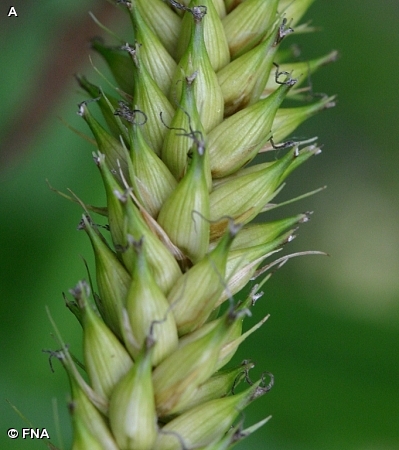
Sedge with well-developed rhizomes forming large clumps or colonies in wet places (B,D). Flowering stems up to 4 feet tall bear 2-4 male spikes at the top, the scales purplish early in the season (E), eventually fading to light brown (F). Immediately below are up to 4 erect or arching female spikes (F). Oval perigynia have long tapered beaks with short teeth (I,J) and red-brown scales (J) that fade late in the season. The light green perigynia turn a deep brown color at maturity (K). Long, broad leaves up to 5/8 inch wide have light brown sheaths, their bases often obscured by the remains of last year’s growth (C).
River floodplains, seasonal wetlands, marshes, wet prairies, ditches. Shoreline Sedge is common along the edge of Great Marsh (D) and in wet depressions along Hidden Lake Trail (B). It has not been observed at Neale Woods. Flowering occurs from early to mid-June. The perigynia persist into early July.
Emory’s Sedge (Carex emoryi) is easily separated from Shoreline Sedge by its flat, lens-shaped perigynia which have short beaks and no teeth. Separating the very similar Smoothcone Sedge (Carex laeviconica) is more challenging. Close examination with a hand lens will show the perigynia of Smoothcone Sedge to have longer teeth. Other perhaps more easily identifiable field marks are its narrower, graceful arching leaves and erect female spikes which are situated well below the males. Stem bases also are firmer and rounder and their sheaths often dissected into distinctive laddered fibers.
The content of NatureSearch is provided by dedicated volunteer Naturalists of Fontenelle Forest who strive to provide the most accurate information available. Contributors of the images retain their copyrights. The point of contact for this page is: Neal Ratzlaff.










